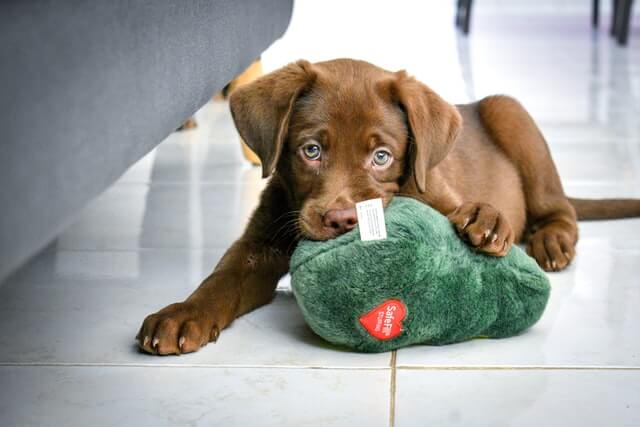By the end of reading this post, you’ll have learned:
- Why crates are actually a good fit for a dog
- How to choose a crate for a puppy
- How to make sure that the crate you choose is the right size
- How to get your puppy to want to go into their crate
- How to deal with potty training issues
- How to get your puppy to sleep through the night in their crate
- How to get your puppy to whine less in their crate
Let’s get started!
Table of Contents
Why Crates are Actually a Good Fit for a Dog
Dogs have denning instincts, meaning that they enjoy resting in safe, enclosed quarters. A crate may seem like a jail or cage to you. But, if introduced properly to a dog, a dog will see it as their space that lets them feel safe.
This is the important part: crate training will fail if it’s used as a punishment. Begin by building positive associations with their crate (more on this later). By doing this, your puppy will see the crate as a positive space.
That said, dogs are also social creatures who need exercise – both physical and mental. Dogs shouldn’t be confined to their crates for too long. The crate should be a place for comfortable downtime. This is especially true during times when they can’t be properly supervised as a puppy.

How to Choose a Crate for a Puppy
There are a whole slew of crates available for dogs: plastic, wire, soft-shell, and more. That said, for puppies, the recommended types of crates are plastic and wire ones.
Other crates may not be appropriate for puppies that aren’t yet trained. They could lead to unsafe conditions. It can be helpful to consult your vet for safety advice.
So, how do you choose between plastic crates and wire ones? Let’s break down the pros and cons of each of them.
Plastic Dog Crates: Pros and Cons
Plastic crates are generally hard-shell crates that have a single door. Sometimes they’ll have small air holes on the sides or even windows. Because of this, plastic crates tend to not allow as much circulation as wire crates. Because the dog can’t see all around him or her, it may feel more like a cozy, safe den. This can definitely help if your dog has anxiety. They’re also quite easy to move around and tend to be light.
Pros
Cons

Wire Dog Crates: Pros and Cons
Wire crates come in different sizes (and can even come in adjustable sizes). Because they’re made of wire, they provide ample opportunity for your dog to see what’s going on around them. This can either make them feel less antsy or potentially increase their anxiety.
Pros
Cons
What Crate to Buy for a Puppy?
For a puppy, it may be good to buy both types to see what type of crate they may end up liking the most. While you’re crate training, it can even be helpful to have more than one crate. This way, you don’t have to keep moving the crate as you move around the house.
If you have a dog, like a labrador, that will grow quickly, a wire crate may be an excellent option. Many of these crates have the option to add dividers to allow the crate to grow with your dog!

How to make sure that the crate you choose is the right size
Choosing the right size of crate for your dog is important. A crate that’s too small and your dog won’t be safe or happy. A crate that’s too big can delay potty training.
Below, you’ll find some guidelines for how to choose the right size for your dog’s crate:
- Current Size of Your Dog: The crate should leave enough room for your dog to stand up, turn around, and lie down. Often, this means it needs to be a few inches longer than they are (including their tail).
- Getting an Extendable Crate: if you’re getting a crate for a puppy, it may make financial sense to get a crate that can have a divider in it
Remember, a crate that’s too small can result in injury. A crate that’s too large can result in housebreaking issues.
How to get your puppy to want to go into their crate
Crate training is like training any other skill. Your puppy won’t immediately understand that he or she is expected to spend time in their crate. Nor will they see that a crate is a restful place. Because of this, you first need to get your puppy accustomed to the crate. It’s your job to crate train your dog! Don’t expect them to see like it right away.
Introduce the crate to them slowly, letting them simply see and smell the crate. You certainly don’t want your puppy to be apprehensive or afraid of the crate.

You can start by placing a few treats around and in the crate. At this point, still don’t make a big deal about the crate. Eventually, he or she will likely explore the crate to see if there are more treats. At this point, just throw a few more in there.
Remember, don’t try to push this too far too soon. This can really hamper the process. Your puppy is likely in their fear imprint period and you’ll need to tread carefully
Always let them come out right away. Once they start offering to go in by themselves, reward them greatly. At this point, you can start working on getting them to enjoy being in their crate.
Get Your Puppy to Like Their Crate with a Toy
At this point, it may be a good idea to place their favorite toy into the crate. At this point, they know a crate is a place where they can get treats. Now they can begin to see it as a place of enjoyment. A toy is a great way to crate train.
While they’re playing with their toy, they’ll likely lie down. If they don’t during the toy session, try luring them into a lie down using treats.

Once they’ve been able to lie down a few times, start closing the door. At first, close it and open it again right away. Eventually, build up to keep it closed for 2 seconds, 5 seconds, etc.
Get Your Puppy to Like Their Crate with a Meal
When they’re comfortable with short periods of their door closed, feed them an entire meal in their crate.
This is the perfect time to close the door. Keep a close eye on them, however. Open the door before they finish eating. They’ll know the door was closed, but also that it opens again!
Because many dogs, especially labs, are food motivated – food is a great way to crate train your dog!

Get Your Puppy to Like Their Crate for Extended Periods
At this point, you can start building up the amount of time your puppy spends in the crate. Leave them in for 5, 15, 30 minutes. Always leave their favorite toy with them so they have a great time!
At this point, your puppy should enjoy being in its crate! Let them see you leave for a few minutes, but always come back. By varying the amount of time you leave, your puppy will realize that they can relax a bit (knowing that you always come back!).
How to Keep Your Dog From Rushing Out Their Crate
Another important skill to train is to get your puppy to leave their crate calmly. Once they’re comfortable being in their crate and want to go out, reward them for going out slowly. If they start barging out of their crate, close the door again.
They’ll soon learn that by sitting still and waiting for YOU to let them out they can leave their crate. This is an incredibly useful skill to teach them! This is a critical skill to add to your list of items to crate train.
How to deal with potty training issues in a crate
The crate can be an incredible housetraining tool for your puppy. But not being mindful of a few things can actually amplify the problem!
Dogs are, by nature, clean animals. They don’t want to lie in their own “business”. Because of this, an appropriately-sized crate will keep them from going potty in their crate.

However, placing soft items like a plush toy or a blanket is a bad idea while they’re still being house trained. The reason for this is that they may pee on the blanket and simply push it to the side.
By not placing soft items in the crate, you can slowly teach your puppy to hold its bladder longer. Similarly, it’ll teach you their signal for needing to go outside!
Conclusion
Phew! Hopefully by following these steps your puppy will learn to love their crate and will be a well-behaved dog in their crate. Successful crate training starts by choosing an appropriate crate for your puppy. Then, you puppy must learn to see their crate as a positive, safe space.
You also learned that it’s your responsibility to crate train and to support your dog in seeing the crate as a safe, positive space!
Crate training isn’t the easiest thing, but it doesn’t need to be the hardest! Each dog is different. Some will take to their crate quickly, and others will need some time. It’s your job to show them that it can be a great place!
Disclaimer
All content on this site is provided for informational and entertainment purposes only. It is not intended to be nor can it be considered actionable professional advice. It must not be used as an alternative for seeking professional advice from a veterinarian or other certified professional.
LivingWithALab.com assumes no responsibility or liability for the use or misuse of what’s written on this site. Please consult a professional before taking any course of action with any medical, health or behavioural related issue.